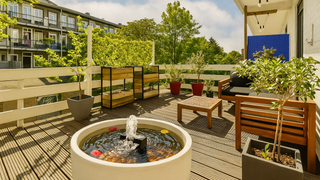
In the midst of a world that's ever more hectic, homeowners are desperate to turn their backyards into sanctuaries of peace. The gentle cadence of water, the balance of stones and foliage, and the simplicity of clean lines can transform even the smallest corner of a backyard into a meditative space. At the core of such a transformation is the zen garden pond—a thoughtfully crafted environment that marries peace with subtle movement, enabling you to reconnect with yourself and with the world.
For thousands of years, Japanese gardens have embodied cooperation between nature and humanity. With suitable design choices and appliances, anyone can introduce the tradition to their own house. Incorporating a pond fountain into a Zen-like environment not only creates calming water features, but also strengthens the sensory experience of a meditative garden. This easy-to-follow guide will walk you through the principal elements: from location and materials to plants, lighting, and the role of eco-friendly Poposoap fountains.
What Is a Zen Garden?
A Zen garden, or karesansui, was designed in Japan as a contemplative space for monks. In the past, it is a dry landscape of sand, rocks, and gravel standing for rivers, islands, and mountains. In the ensuing centuries, garden design allowed for ponds, bridges, and water features—providing a literal flow to the symbolic one.

Modern Zen gardens blend these traditions. They balance nature elements—water, stone, wood, and plants—in a way that calms the mind. In this sense, a zen garden pond is both a centerpiece and a metaphor. Water reflects the sky, comes and goes with life, and provides shelter for birds and insects, enriching the ecological community while encouraging mindfulness.
Poposoap's brand narrative highlights harmony with nature. Their fountains and filters powered by the sun are not only useful devices but also aspects that contribute to balanced ecosystems—ideal for someone who prefers to integrate Zen concepts with green design.
Fountain Placement for Peace
The position of your pond fountain is essential to the attainment of peace. Water must be there, but never in excess.
Balance and Symmetry: Balance in Zen philosophy is not about perfect symmetry but about harmony among elements. Position your fountain slightly off-center in the pond so there is natural movement that appears to be spontaneous, not choreographed.

Sound Levels: Water noise may be soothing or distracting. Choose a fountain that has an adjustable flow, such as the solar models by Poposoap, to regulate the trickle or bubbling sound. For meditation, a light flow is good, but an increased spray might be better for open spaces.
Integration with Rocks: Situate natural rocks around the fountain to edge it, guiding the eye without covering the space. Flat rocks could serve as symbolic "bridges" or patio-like spaces beside the water.
Viewing Points: Think about where you will sit or stand when you relax in your garden. Put the fountain where sound and sight will enhance relaxation.
By carefully placing your fountain, you set the mood for your whole meditative garden experience.
Materials and Design Techniques
A Zen garden relies heavily on natural, plain materials. The layout needs to encourage flow, simplicity, and functionality.
Rocks and Pebbles: Use gravel to imitate still water and large stones to represent mountains. Position raked gravel pathways leading around the pond to guide visitors to sit and reflect.
Wood Features: A humble wooden bench or bamboo trimming can add warmth to the look without sacrificing minimalism.
Water Features: Keep them low-profile. A diminutive peaceful water feature run by the sun merges practicality with eco-friendliness. Poposoap fountains live this credo—simple to setup and non-reliant on complex wiring.
Layout Flow: Don't overdo it. Pond and fountain should be the focal point, with other things—plants, rocks, lanterns—situated sparingly to frame the view.
A Zen garden is not one of extravagance but of purpose. Every item should be like as if set with purpose.
Plants Harmony
Plants bring softness and seasonality to the Zen garden. They symbolize cycles of life and connect your garden with the cycle of time.
Evergreens: Junipers and pines bring constant greenery throughout the year and are staples of traditional Zen landscape design.
Grasses and Bamboo: They bring movement in the wind, complementing the calming flow of your fountain.
Water Plants: Lilies and lotus not only purify water but also serenity to the pond. They're excellent companions to solar pumps, providing shade that inhibits algae growth.
Moss and Groundcovers: Moss adores shaded, damp areas and softens stone edges. It's perfect for creating an antique, weathered look.

Seasonal Blooms: Restricted colors, like irises or azaleas, add muted beauty without overwhelming the serene color scheme.
By combining evergreens with water plants and subtle groundcovers, your zen garden pond is a living sculpture that changes shape with the seasons.
Light and Silence
Nights are also an overlooked time for having a Zen-inspired garden. Lighting is one means of making the garden accessible into the evening while keeping the serenity.
Soft Solar Lights: Poposoap's solar light solutions can highlight the fountain or pathway without harsh glare. Warm white colorings are ideal for nighttime meditation.
Lanterns: Stone lanterns, a classic element in Japanese gardens, can be stationed along the side of the pond for beauty and symbol.
Silence and Sound Equilibrium: Proper Zen spaces are all about equilibrium. Silence and sound have the same importance. There must be some quiet places in your garden where water flow is barely noticeable, and there should be places where trickling water creates ambiance.
This equilibrium between light and sound provides a complete sensory experience—there is room to meditate whenever.
Final Thoughts
Creating a zen garden pond fountain is more a case of function and less one of aesthetics. Using natural elements, exacting design, and peaceful soothing water elements, you create an oasis where life seems to move at a slower speed and is heavier in terms of significance.
Poposoap's green filters and fountains are in complete sync with these principles. Their solar-based units provide a consistent supply of water without disturbing the balance of nature, and their ideology of operation is one of eco-stewardship and minimalism.
Plants, stones, and lighting integrated into your contemplative garden guarantee a place not only that fosters biodiversity but also inner tranquility. Mindful sitting, greeting guests, or merely a moment of serenity with the comforting rush of running water, your Zen garden will be more an atmosphere than landscape, a living embodiment of balance.
Frequently Asked Questions (FAQ)
What is a modern zen garden pond?
A modern zen garden pond blends traditional Japanese karesansui (dry landscape) principles with water features. It balances natural elements—water, stone, wood, and plants—to create a contemplative space. The pond serves as a centerpiece, reflecting the sky, supporting wildlife, and encouraging mindfulness, while fountains add subtle movement and calming sound.
How should I place a fountain in my zen garden pond for peace?
Position the fountain slightly off-center for natural, spontaneous movement (not perfect symmetry). Regulate sound with an adjustable flow (light trickle for meditation, stronger spray for open spaces). Surround it with natural rocks to guide the eye, and place it where you’ll easily see and hear it from relaxation spots (seats, pathways).
What plants are best for a zen garden pond?
Opt for plants that enhance serenity and balance: evergreens (junipers, pines) for year-round greenery, grasses/bamboo for gentle movement, water plants (lilies, lotus) for water purification and shade, moss/groundcovers to soften stone edges, and muted seasonal blooms (irises, azaleas) for subtle color without overwhelming the space.
Why are solar-powered fountains like Poposoap's good for zen gardens?
Solar fountains align with Zen’s eco-friendly and minimalist principles—they’re wire-free (no complex wiring), run on sunlight, and maintain natural balance. Poposoap’s models are low-profile, easy to set up, and have adjustable flow to control sound, perfect for creating a calming, unobtrusive water feature.
What materials work best for a zen garden pond design?
Stick to natural, simple materials: gravel (to imitate still water), large stones (representing mountains), wooden elements (humble bench, bamboo trimming) for warmth, and low-profile water features. Avoid extravagance—every item should have purpose, framing the pond/fountain as the focal point.
How can I use lighting in a zen garden pond for nighttime use?
Use soft solar lights (like Poposoap’s solar pond lights) to highlight the fountain or pathways—warm white tones are ideal for nighttime meditation. Add stone lanterns (a classic Zen element) for symbolism and subtle glow. Balance light with silence: ensure some areas have minimal light for quiet contemplation, paired with gentle water sounds.







